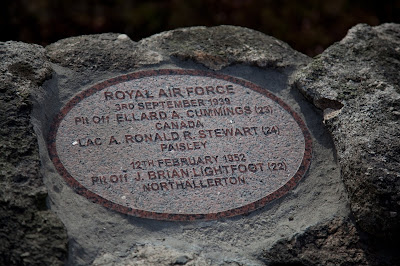THE FAMOUS DIGGERS OF GEORGE SQUARE – by Duncan Harley
George Square in Inverurie was built over several years by a town council intent
on improving the local housing stock. Slum clearance was an issue and an
enlightened group of councillors financed construction in the years prior to
the Hitler war. The conflict of course intervened and it was not until the late
1940’s that the housing scheme was completed and fully occupied.
Meantime Polish troops had occupied, and vandalised, some of the new-builds and
a general rent-review had been agreed with slum-tenants from Constitution
Street who had refused to move to the new-build properties on cost grounds.
Oddly
perhaps, the newly built housing scheme became a local icon for wartime self-sufficiency.
Rationing during
the early years of WW2 led to a dramatic increase in demand for agricultural land
throughout the county of Aberdeenshire. Marginal land, parkland and golf
courses, including the old course at Turriff, were sacrificed to the plough and
fallow land was brought into use.
In the October of 1941, Inverurie Golf Club actually petitioned the council, requesting that the course be put under cultivation in return for a nominal rent; not out of patriotic duty perhaps, but because membership had declined due to wartime conditions leaving the club unable to finance ground maintenance. Inverurie’s Lands and Parks Committee was the wartime body tasked with inspiring the townsfolk to grow their own and, with Ministry of Agriculture backing via the Dig for Victory campaign, councillors appealed to the public to take up an initial offer of rent-free plots.
In the October of 1941, Inverurie Golf Club actually petitioned the council, requesting that the course be put under cultivation in return for a nominal rent; not out of patriotic duty perhaps, but because membership had declined due to wartime conditions leaving the club unable to finance ground maintenance. Inverurie’s Lands and Parks Committee was the wartime body tasked with inspiring the townsfolk to grow their own and, with Ministry of Agriculture backing via the Dig for Victory campaign, councillors appealed to the public to take up an initial offer of rent-free plots.
Demand
proved strong and by March 1940, all 34 plots at both George Square and Allan
Place had been let. Soon after, wasteland at Victoria Street was brought into
cultivation. A meeting was subsequently held at the local Town Hall, during
which Bailie Mitchell, convenor of the Lands and Parks Committee, proposed the
formation of an Allotment Holders Association. Benefits would, he explained, include
discounts on the bulk purchase of seed, fertiliser and implements. An annual fee
would be fixed at 13 pence for the rental of plots measuring 50 square yards.
Advice on cultivation was offered and cartons of seeds were sold at 39 old pence per 13 varieties, with discounts for OAPs and those on low income. By 1941, demand was such that an additional area of 60 acres between the Lochter Burn and the River Ury was incorporated into the scheme. Known locally as the Docken Hole, this unimproved land had lain fallow for some 80 years. Eventually, around 25% of Inverurie householders registered as plot holders and Bailie Mitchell was driven to announce that “we have some very famous diggers in George Square…we must go down and see them and give them some encouragement.”
In the September of 1941, a Victory Garden Show was held in the local Drill Hall on Constitution Street, with prizes awarded for best plot holder and best garden plot. Proceeds of £49 were donated to the Red Cross.
A reporter from the Bon Accord and Northern Pictorial was in attendance and recorded, in an extensive article headed ‘A Sure Sign’, that local man, Angus Stuart, had exhibited a large V-for-Victory shaped potato. The Prime Minister of the time, the cigar wielding Winston Churchill, was no doubt impressed.
Advice on cultivation was offered and cartons of seeds were sold at 39 old pence per 13 varieties, with discounts for OAPs and those on low income. By 1941, demand was such that an additional area of 60 acres between the Lochter Burn and the River Ury was incorporated into the scheme. Known locally as the Docken Hole, this unimproved land had lain fallow for some 80 years. Eventually, around 25% of Inverurie householders registered as plot holders and Bailie Mitchell was driven to announce that “we have some very famous diggers in George Square…we must go down and see them and give them some encouragement.”
In the September of 1941, a Victory Garden Show was held in the local Drill Hall on Constitution Street, with prizes awarded for best plot holder and best garden plot. Proceeds of £49 were donated to the Red Cross.
A reporter from the Bon Accord and Northern Pictorial was in attendance and recorded, in an extensive article headed ‘A Sure Sign’, that local man, Angus Stuart, had exhibited a large V-for-Victory shaped potato. The Prime Minister of the time, the cigar wielding Winston Churchill, was no doubt impressed.
Duncan
Harley is author of two books about Aberdeenshire. Both, The Little History of
Aberdeenshire and The A-Z of Curious Aberdeenshire, are available from Amazon.











Comments
Post a Comment